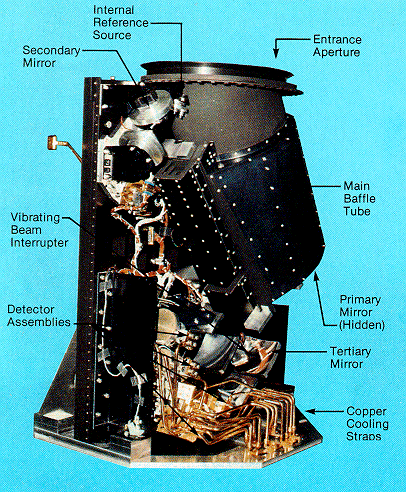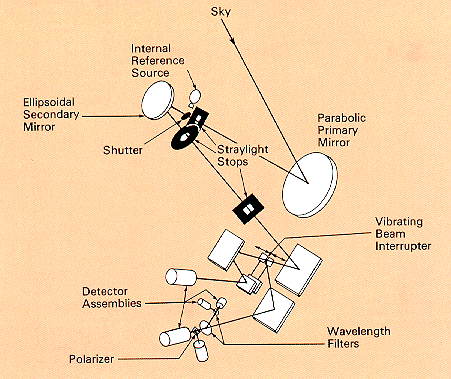
![[ADF logo]](adf.gif)
As a result of the cosmic redshift and reprocessing by dust of short-wavelength radiation, the wide spectral range from 1 to 1000 microns is expected to contain much of the energy released since the formation of luminous objects. The cosmic infrared background (CIB) could potentially contain a total radiant energy density comparable to that of the microwave background.
The primary aim of the DIRBE is to conduct a definitive search for an
isotropic CIB radiation and to measure its energy distribution. Secondary
objectives include studies of foreground astrophysical sources: scattered
sunlight and thermal radiation from the interplanetary dust, thermal emission
from interstellar dust, and Galactic starlight. The observational approach
is to make absolute brightness maps of the full sky at ten wavelengths
from 1.2 to 240 microns (see table below), and to map linear polarization
at 1.2, 2.2, and 3.5 microns.
| Spectral
band |
Wavelength
(microns) |
Effective Bandwidth*
(THz) |
| 1 | 1.25 | 57.0 |
| 2 | 2.2 | 22.5 |
| 3 | 3.5 | 22.0 |
| 4 | 4.9 | 8.21 |
| 5 | 12 | 13.5 |
| 6 | 25 | 4.10 |
| 7 | 60 | 2.32 |
| 8 | 100 | 0.974 |
| 9 | 140 | 0.617 |
| 10 | 240 | 0.496 |
* Assumes source spectrum nu*I(nu) = constant.

Important design features of the DIRBE include the following: (a) absolute
photometric measurements are made by chopping at 32 Hz between the sky
signal and a zero-flux internal surface; (b) a full-beam shutter can be
closed to measure instrumental offsets; (c) all spectral channels simultaneously
observe the same 42' x 42' square field of view on the sky; and (d) each
celestial line of sight is viewed from all accessible solar elongation
angles within the range from 64 to 124 degrees (the actual range depending
upon ecliptic latitude), providing variable viewing geometry from within
the interplanetary dust cloud.
The DIRBE instrument operated at cryogenic temperatures for ten months, from 24 November 1989 to 21 September 1990, mapping the full sky with high redundancy during the first six months, and covering most of the sky with similar redundancy during the following four months. After the cryogen ran out, the DIRBE continued to provide photometric and polarimetric data, at reduced sensitivity, in the near-infrared until the instrument was turned off in December 1993.
For detailed information about the experiment, instrument calibration, and data products, see the DIRBE Explanatory Supplement.
Results of the search for the cosmic infrared background are reported in papers by Hauser et al. (1998), Kelsall et al. (1998), Arendt et al. (1998), Dwek et al. (1998), Fixsen et al. (1998), Dwek and Arendt (1998), Gorjian, Wright, and Chary (2000), and Wright and Reese (2000). The Bibliography of COBE Team Publications provides links to a number of other papers describing the results of non-cosmological DIRBE data analyses.
David Leisawitz, leisawitz@stars.gsfc.nasa.gov
Astrophysics Data Facility, Code 631, NASA/GSFC
Greenbelt, MD 20771, USA
Last revised: 8 March 2001